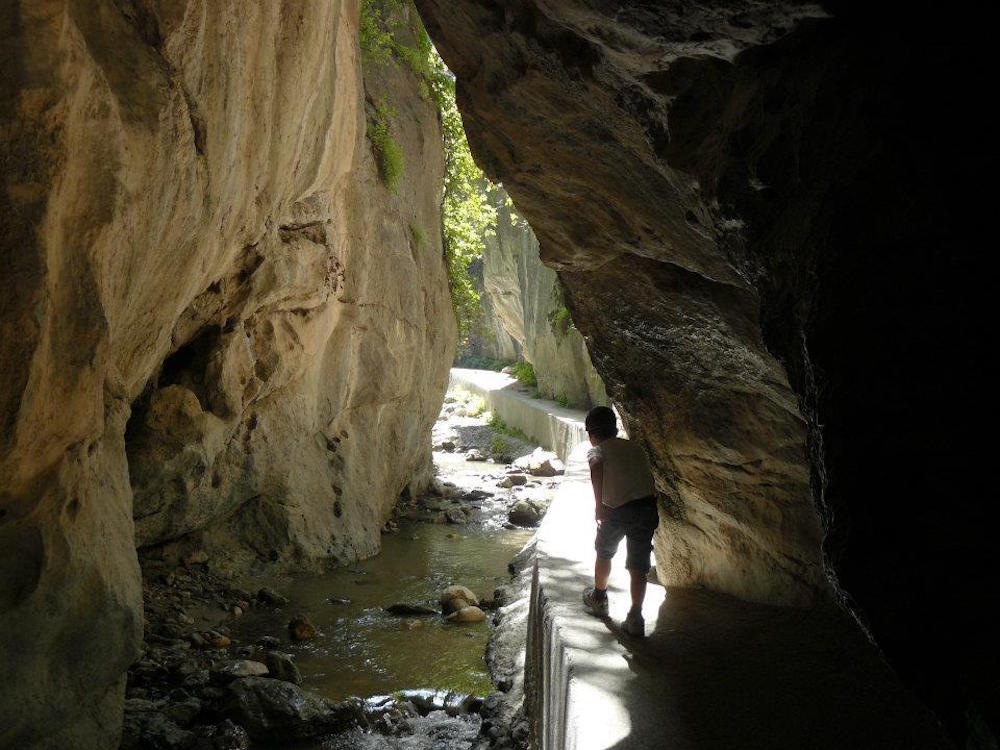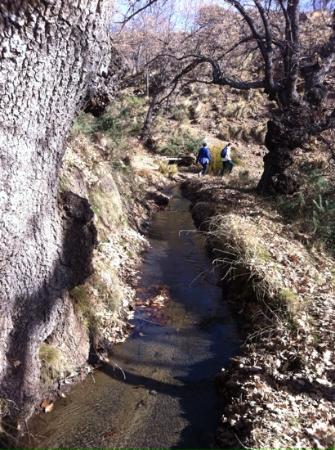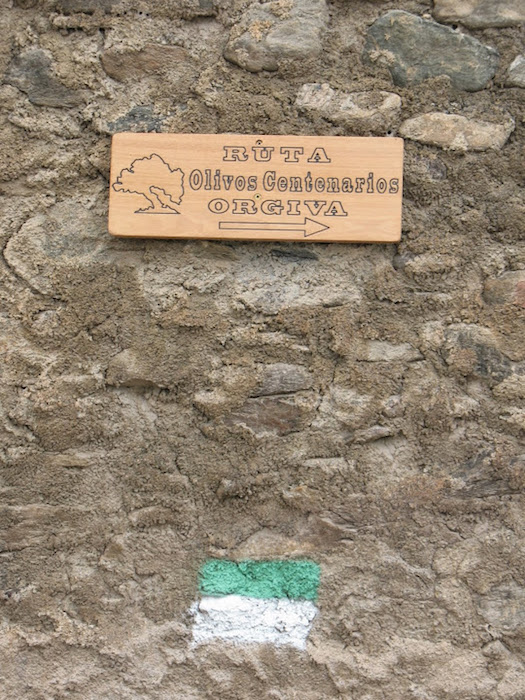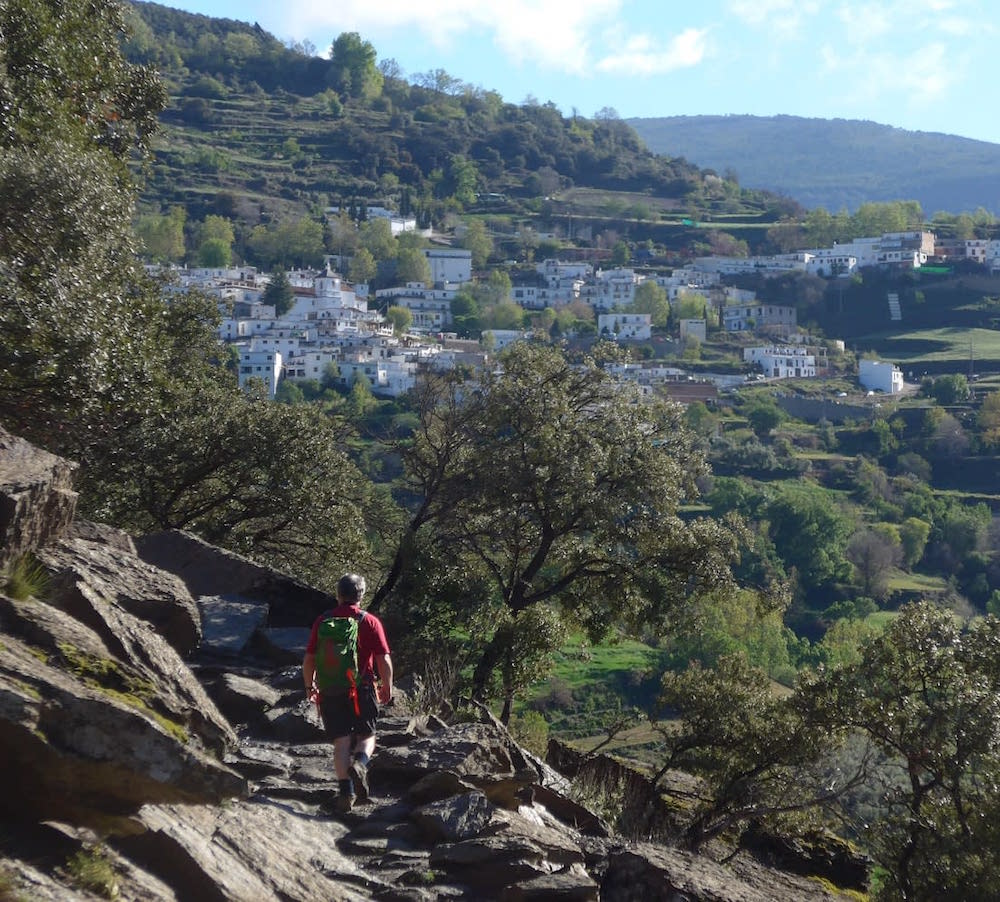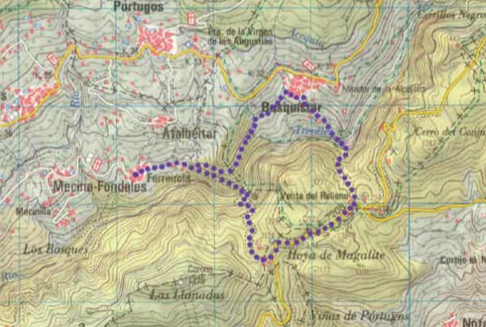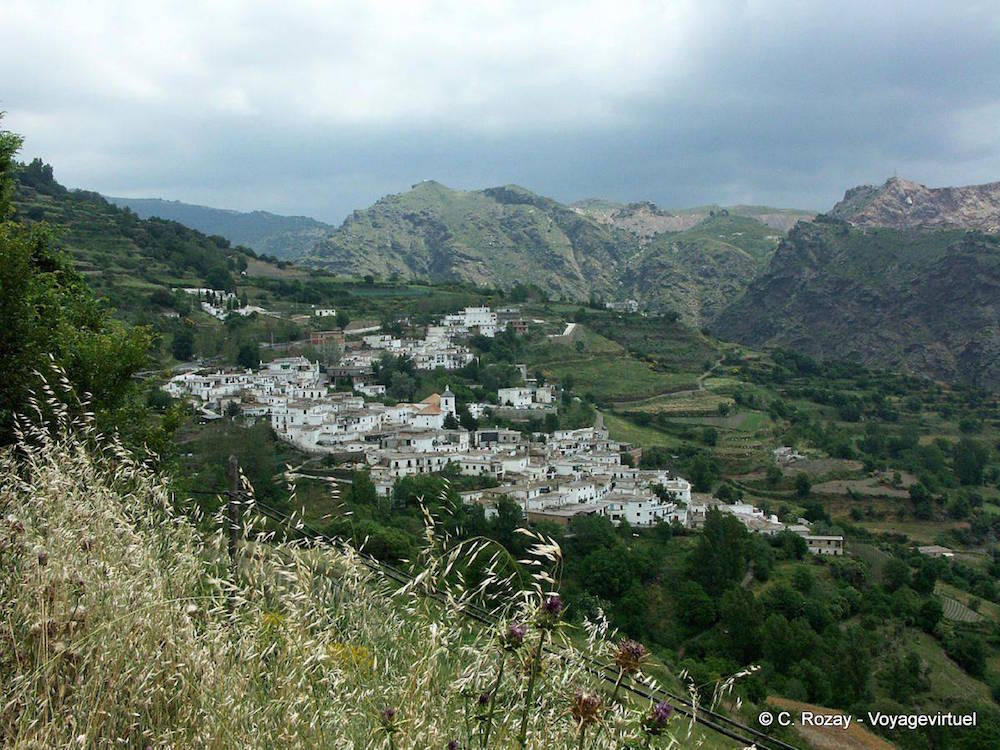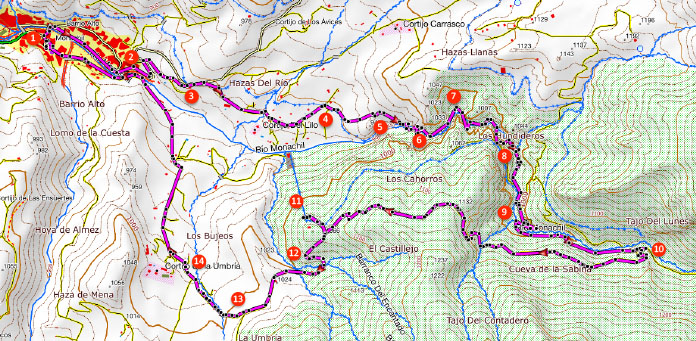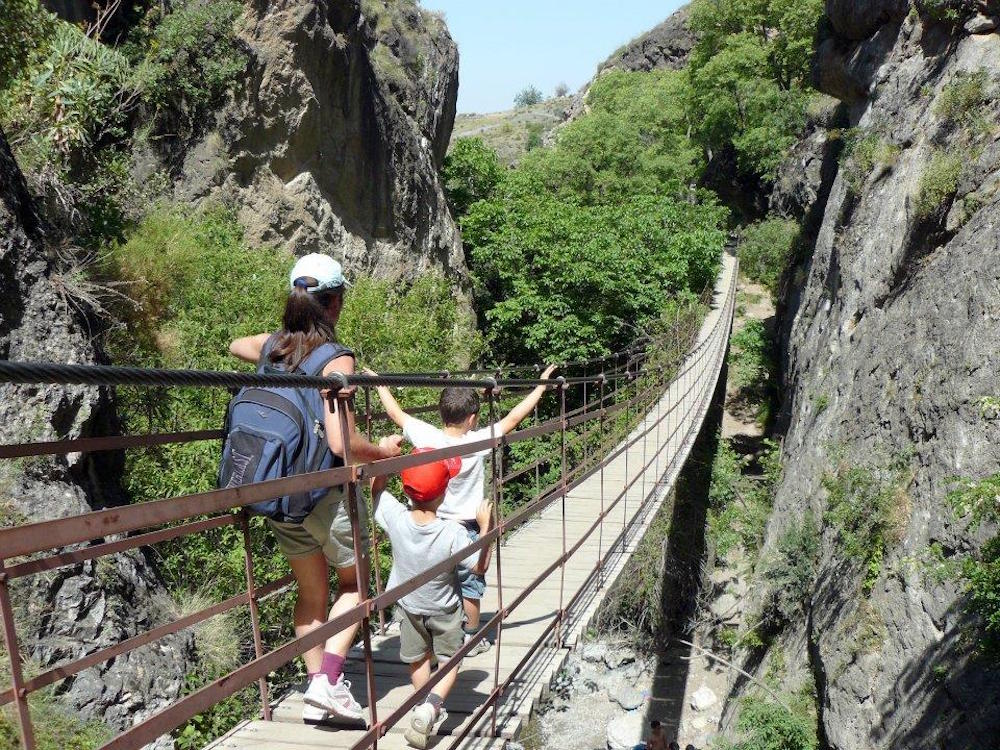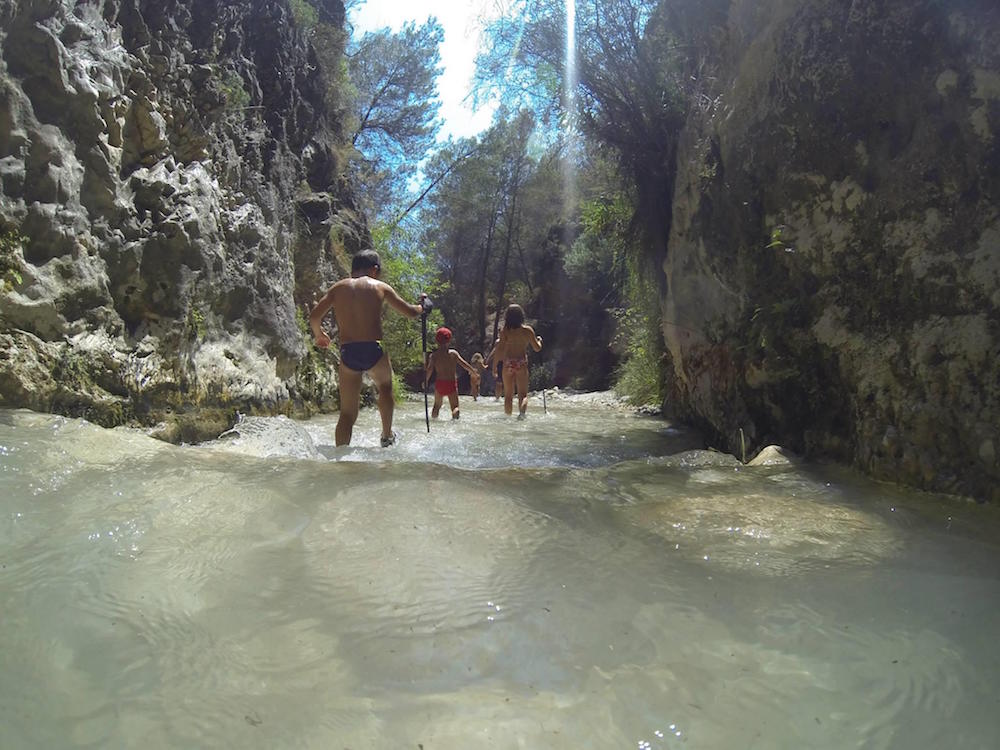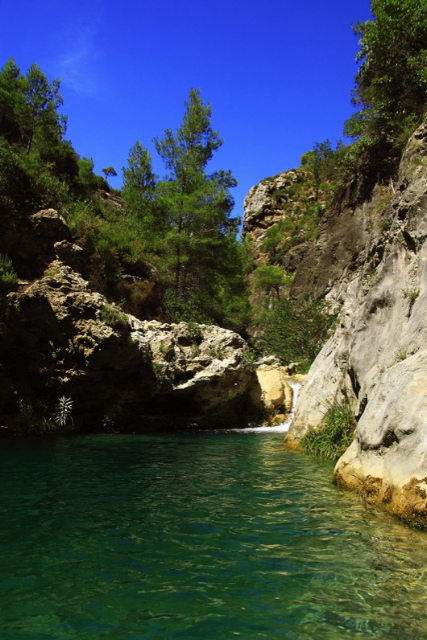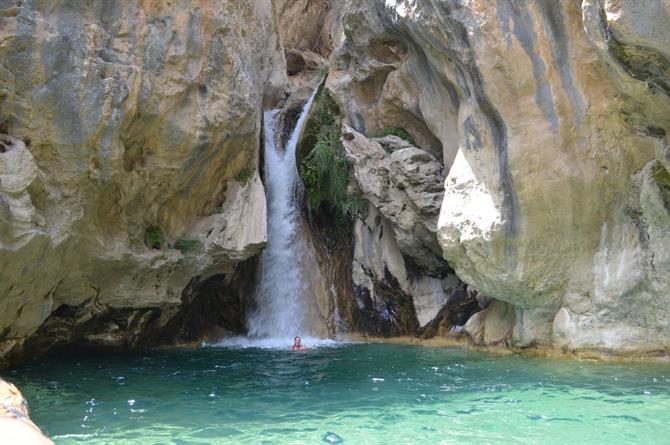
The region around Órgiva is a walker’s paradise and Rural Paradise is an excellent base from which to enjoy many and varied walks. There are some walks directly from Rural Paradise and others that you need to drive to. You can walk along the flat promenades of the coastal villages, the gentle rises around Rural Paradise, the dry and wet river beds, follow the acequias (man-made water channels) and the many trails in the surrounding mountains.
Whether you are interested in high altitude treks in the peaks of the Sierra Nevada, many of which are over 3,000 metres or casual meandering around the fascinating villages of the high Alpujarra, this area is a fabulous area for walking. The GR7 path (Gran Recorrido) which begins in Tarifa in Cadiz province and crosses Europe all the way to Athens in Greece passes through the Alpujarras and there is an extensive network of other tracks to choose from. The paths are well sign-posted and are often old mule tracks - so the steepness is no more than a loaded mule can manage! The area is never crowded with walkers and you can often be out in the mountains all day and encounter no more than a shepherd with his flock.
If you choose your walks carefully and are prepared to make the most of the day then walking is possible here at all times of year. For example, in August, when the lower valleys are possibly too hot for vigorous activities, temperatures in the accessible high mountains may not go much above 20 degrees centigrade. The best months to walk in Las Alpujarras are April to mid-June, and September to mid-November.
Tips for walking and hiking:
- Take a good quality walking map or compass with you. Do not rely on cell signal or batteries.
- Wear good quality, sturdy, waterproof walking boots. Trekking poles are great in rough sections.
- Let someone know where you are going.
- Take a mobile phone or GPS if possible. For longer trips take extra batteries.
- Take plenty of water as southern Spain can be really hot.
- Protect yourself from the sun, it is better to avoid walking in the heat of the afternoon.
- Wear suitable clothes, layers are good as although it may be hot at lower altitudes, it can be cold higher up.
- Keep to a clear path and avoid taking shortcuts unless you are absolutely confident of the area.
- Be aware that the weather can change very quickly and fog, rain, or storms, especially lightning, can occur quickly and without warning.
- Be aware that dry riverbeds and streams can quickly flood during bad weather.
- Help to protect and maintain the area you are walking through.
There are self-guided walks some of which have downloadable PDFs with detailed maps, altitude profiles and step-by-step descriptions for you to take with you, as well as tracks that you can load onto a GPS device or mobile, so that you’ll have all the information you need when you’re out walking. Alternatively, you can hire a guide.
Typical prices to hire a guide
If you would like to hire a guide for your outing, typical daily rates for leading you in the hills or mountains start from about €30 per person, depending on the number of people and activities. Examples are:
1 day hill walking in ‘low level’ areas:
- 1-2 People €80 per person
- 3 People €70 per person
- 4 People €60 per person
- 5 People €50 per person
- 6-8 People €45 per person
1 day walking in the mountains and summits:
- 1-2 People €100 per person
- 3 People €80 per person
- 4 People €65 per person
- 5 People €60 per person
- 6 People €50 per person
- 7-8 People €45 per person
Climbing Mulhacén or Alcazaba using the Sierra Nevada National Park bus from Capileira as a day excursion:
- 1-2 People €112 per person
- 3 People €92 per person
- 4 People €77 per person
- 5 People €72 per person
- 6 People €62 per person
- 7-8 People €57 per person
- Prices do not include the bus fare of approximately €12 per person.
Climbing Mulhacén over 2 days overnighting at the Poqueira Refuge (including meals except for your packed lunch on day 1):
- 1 Person €320 per person
- 2 People €260 per person
- 3 People €220 per person
- 4 People €190 per person
- 5 People €170per person
- 6 People €160 per person
- 7 People €150 per person
- 8 People €140 per person
1 day rock scrambling (max 4 people per guide)
- 1-2 People €120 per person
- 3 People €100 per person
- 4 People €80 per person
Useful websites
To help you further in planning your holiday at Rural Paradise here are a few websites you may wish to look at.
- Alpujarras
- The Life of Riley
- Sierra Nevada Guides
- Trek Sierra Nevada
- Walking in Andalucía
- Alpujarra Walking Holidays
Some walks for you
These are just some of the many walks available to you. We have divided them into 3 sections.
- Directly from Rural Paradise
- Within 1 hours drive
- Within 1.5 hours drive
Directly from Rural Paradise
Pago
This walk will take about 1 hour.
Leave Rural Paradise heading uphill towards Órgiva and turn left into Pago (first left). Follow the road and track downhill until you reach what is a T-junction. Turn left across the Río Chico and continue along the track until it becomes a tarmac road. The Seven Eyes Bridge is now visible. Turn left almost immediately the track becomes tarmac. Follow that road uphill until you get to the house featuring a large ornamental orange and lemon on the roof. Turn left immediately before this house and follow the track towards the Río Chico. Turn right and walk alongside the Río Chico for about 50m and then cross the river bed continuing along the track and you emerge onto Camino de la Estrella right next to Paraíso Rural.
El Morreón & Río Guadalfeo
Leave Rural Paradise heading uphill towards Órgiva and take the left turn towards El Morreon (this is the next left after the turn for Pago and opposite the Chico Bar) and then follow the road/track down to the Río Guadalfeo. Walk up river turning inland before the Río Chico, cross the river bed and continue along the track until it becomes a tarmac road. The Seven Eyes Bridge is now visible. Turn left almost immediately the track becomes tarmac. Follow that road uphill until you get to the house featuring a large ornamental orange and lemon on the roof. Turn left immediately before this house and follow the track towards the Río Chico. Turn right and walk alongside the Río Chico for about 50m and then cross the river bed continuing along the track and you emerge onto Camino de la Estrella right next to Paraíso Rural. This walk will take about 2.5 hours.
Órgiva
Head into Órgiva to explore and enjoy a drink and tapas. Remember, with every alcoholic drink you get a free tapas, only in Granada province!
Leave Rural Paradise taking La Camino de la Estrella towards Órgiva. It is about a 2.2 km walk with a rise of just over 100 meters that should take you no more than 30 minutes (we often do it in 20!). When you get to the main road bridge over the Río Chico turn right over the small bridge below the main one. Once over the river turn left up the steep hill. At the top turn right and right again at the T-junction.
Go straight ahead passing the small BP station (there is a big BP station!), El Limonero restaurant and bar (maybe stop here on the way back for a drink) and the Mirasol Hotel (both on your left). Further on you pass a small fruit and vegetable shop where you can get nice, fresh locally grown produce and then the Post Office (Correos). Follow the road around to the left and a bit further on you will find the Alpujarra Supermarket (a favourite of ours) on the right. After about another 50 meters El Viejo Molino bar and restaurant is on your right (a popular watering hole for us).
At the traffic lights turn left and go past the twin towers of Órgiva's main church. Along this cobbled street are many bars and cafes and ATMs (if you need some cash!). At the top of the street is the local police station, here the road turns right and you come into the Plaza de Alpujarras. In the warmer weather enjoy a drink at Mario's bar and restaurant at the top corner of the square.
The Alpujarras square is a good base from which to explore Órgiva. Walk up to the high part of town and look at the other church in town and take in the views. Go off the main roads and explore the many small side streets heading downwards to the lower part of Órgiva where, back on the main road you will find the Día supermarket and looking ahead are great views looking up the Río Guadalfeo valley. On the main road Bar Cañadas is a nice, friendly bar to pause at, perhaps shoot a game of Pool.
When you are ready, follow the main road through town back past the small BP station. The way back to Rural Paradise is downhill so don't forget to stop in at El Limonero for a swift one!
Route of the Olives
This walk is about 7.2km and will take about 2.5 hours.
In Spanish this is Ruta Olivos Centenarios. It starts on the south east side of Órgiva on Camino del Monarca. This road is off the main through route for Órgiva (A-348) opposite the Bar Mirasierra. The coordinates are (for sat nav) 36°53'49.9"N 3°25'14.7"W and (for Google Maps) 36.897195, -3.420742. From Paraíso Rural it takes about 35 minutes to walk to the start.
The road is concreted and traces a large loop downhill rejoining the A-348 just above Camping Órgiva. Turn left and down the A-348 towards the Seven Eyes Bridge over the Río Guadalfeo. Just before the bridge and opposite the bar/restaurant Venta el Puente turn right. The road drops steeply and twists bringing you to the base of the bridge. Continue to follow the road running alongside the Río Guadalfeo. The tarmac road eventually gives way to a dirt/stone track. Keep straight ahead following the twists and turns. You pass a goat farm on the left. Depending on the time of year you can see the baby goats running around. Continue to follow the track.
You arrive at the ford across the Río Chico. The river is dry for most of the year but in the winter months may have running water. In this case use the wooden footbridge just above the ford (be careful going down the bank to the bridge). Having crossed the Río Chico you turn right after about 20m and walk uphill along Pago (a dirt/stone track). After about 500m you can look left to see the Río Guadalfeo valley wending its way to the Mediterranean Sea. Continue uphill along Pago until you reach a junction. Turn left here (you will see a sign for the Ruta Olivos Centenario).
This continues to be a dirt/stone track and twists and turns upwards. Continue uphill along Pago following its twists and turns (it becomes a concrete road). You will arrive at a T-junction. Turn right. We call this the El Morreón Road. Follow this road eventually passing on your right the old Benisalte Mill. Shortly there after the road dips steeply and levels off to bring you Camino de la Estrella near the Chico Bar. At this point you can turn left to Órgiva or right to Paraíso Rural.
Within 1 hours drive
Los Mineros – Miner’s route – Orgiva
 This walk is about 8.2km and will take roughly 3 and a half hours.
This walk is about 8.2km and will take roughly 3 and a half hours.
The suggested route is more than just a path, it is a journey through the mining history of the Sierra de Lújar. Mining has been the backbone of the economy in Las Alpujarras since immemorial time, and was especially important in Órgiva from 1800 to 1989.
You begin following the track from El Castillejo, a small hill with remnants of an old castle, just oposite Orgiva on other side of the river Guadalfeo. After a few meters following the road, turn left uphill, to begin the ascend, following a path for about three kilometers. This is the path which the miners from Orgiva had to use every day to travel to work at the mine. The first stage is very demanding, as the steep path gains height vey quickly. Whole area offers superb views over the region of Orgiva valley. All along the path you will find information boards which explain the mining history of the area which the path passes through. The surrounding vegetation here consists of a thick carpet of rockrose, gorse, rosemary and thyme.
During the path you can pause for a moment to think of the lives of the mine workers. At this point, they still had a long walk ahead of them to get to work, and they had to arrive there at dawn to begin their working day.
The descent route which the path follows offers the chance to enjoy the delightful countryside which is spread out before you as you descend gently, with Orgiva and the highest peaks of the Sierra nevada as a backdrop.
Lower part of this route is also well mantained and popular rock climbing area, which is divided into 3 main sections. You will find there climbing routes suitable for all ages, with difficulty grades from 4 to 8.
Medieval route
The Medieval route of Las Alpujarras is a historical walking path and crosses several paths of medieval origin, mostly documented. It begins in Pórtugos and ends in Juviles and is divided into four sections:
- Pórtugos - Busquístar
- Busquístar - Cástaras Portichuelo
- Cástaras portichuelo - Nieles
- Nieles - Juviles
In addition to the main Medieval route, there are other trails and paths dated as medieval in La Alpujarra area. They can form alternative or complementary itineraries.
Part 1 - Pórtugos to Busquístar via Ferreirola
This part of the walk is about 4.7km and will take roughly 1 and a half hours.
Begin the Medieval route in Pórtugos, descending to Atalbéitar, and share your path with the GR-7 international route. Continue descending until Ferreirola, and leaving the town, link with the GR-142 route until the end of this first part of the Medieval route in Busquístar.
Part 2 - Busquistar to Cástaras Portichuelo
This part of the walk is about 4.2km and will take roughly 1 and 45 minutes.
Start the second part of the Medieval hiking route in the Alpujarran village of Busquístar, from where you go down to the Río Trevélez and cross the bridge. Then ascend 300 meters, the so-called escarihuela del Portichuelo until you reach Portichuelo de Cástaras, where you complete the second part of the Medieval route.
Part 3 - Cástaras Portichuelo via Cástaras to Nieles
This part of the walk is about 5.6km and will take roughly 1 and 45 minutes.
The third part of the Medieval Las Alpujarras hiking route begins in Portichuelo de Cástaras, from where you descend along a beautiful path, with tunnel included, until you reach Caminillo Viejo, a path that runs along the southern slope of the Cerro Mancilla. On the route you will see the remains of Minas de Mancilla, from where the Medieval route coincides with the GR-142 trail to Nieles.
Part 4 - Nieles to Juviles
This part of the walk is about 6.5km and will take roughly 2 hours.
The last part of the Medieval route of the Alpujarras connect the towns of Nieles and Juviles and start initially via path GR-142. Later you turn to the path camino de la vega, dating from the 15th century, and after that you cross the river. Now climb a steep slope to continue the path next to the irrigation channel of Lobrasán. Finally, you continue by the old road Camino Viejo de Tímar to Juviles.
This walk is about 8.2km and will take roughly 3 and a half hours.
This is a very picturesque route, which passes through some areas of dense and varied vegetation. Most striking among this is a large grove of chestnut trees. It also passes many ruined and abandoned country houses known as cortijos, and their adjoining terraced farmland.
Follow the track which starts from this point on the main road for about 700 metres, and then cross the river by the bridge which is next to the public recreation area. Begin the ascent uphill by a path which zigzags across the slope.
A few minutes after beginning to ascend, take a path off to the left that will take you to a forest trail, which you then follow to the right to continue the route. This area offers some excellent view of the three villages of Poqueira Valley: Capileira, Bubión and Pampaneira, with the mountains in the background.
After about 2 kilometres the path leads to "Cortijo de Banuelo". The descent from here is along a track which leads back to the bridge crossed at the start of the walk.
The route involves a tour of the district of La Taha, taking you through several of its villages including pitres, Capilerilla, Mecina, Mecinilla, Fondales, Ferreirola and Atalbeitar. These villages date back to Roman times. Here you can enjoy a peace and tranquility which simply isn't found elsewhere.
The walk begins in Pitres, the capital of this group of villages, where you can see the charming tower of the church which was built on the foundations of an ancient mosque.
From here, drop down along a path which has an excellent view over Río Trevelez. This leads to the village of Mecina, where you need to take the first side street heading right to get to the mainroad, by which you reach Mecinilla.
Cross the village aiming for the lowest point, where you will find another path which leads to Fondales. This is reputed to be one of the purest villages in the region of la Alpujarra, as its original architeture has been preserved virtually intact. In the highest part of the village, where you will come across a square, continue by going left to get to the valley through which Río Bermejo flows.
Follow the trail which continues up towards Ferreirola, a tiny village of ancient houses and public laundries, which has an unusual natural spring of sparkling water. The last stage of this walk follows the same route as the Gran Recorrido GR-142, one of the European long-distance walking routes, which runs between Lanjaron (Granada) and Finana (Almeria).
This walk is about 2.5km and will take roughly 45 minutes.
The paths known as Acequia Alta and Acequia Baja (the upper and lower water channels) together make up a route which has a gentle incline, and takes the walker through a chestnut wood which is home to many ancient and gigantic specimens of these noble trees (some of the trunks measure more than 8 metres round the base).
The best time for doing these walks is during the "Fiesta de las Castañas" (the festival of the chestnuts), which takes place early in November or at the end of October.
The higher path, Acequia Alta, offers excellent views of the whole valley of the Mecina Bombaron.
To follow the route, take the path up the gradual slope and, after passing the "Balsa del Castillo" reservoir, cross the "Barranco del Molinillo" ravine. Moving onwards, pass the "Cortijo de los Llanos" on the left. The route finishes a few metres further on after crossing the "Barranco del Avenal" ravine.
This walk is about 1.7km and will take roughly 30 minutes.
The paths known as Acequia Alta and Acequia Baja (the upper and lower aqueducts) together make up a route which has a gentle incline, and takes the walker through a chestnut wood which is home to many ancient and gigantic specimens of these noble trees (some of the trunks measure more than 8 metres round the base).
The best time for doing these walks is during the "Fiesta de las Castanas" (the festival of the chestnuts), which takes place early in November or at the end of October.
The lower path, Acequia Baja, leads to Río Mecina, which winds its way along the valley in the shade of the chestnut woods.
This is a short route with a gentle incline, dominated by the aqueduct which runs parallel to the path. After less than two kilometres you will reach the source of the water channel in the Mecina Bombaron River, and this marks the end of the route.
Pedro A. de Alarcon – Torvizcon
This walk is about 8.3km and will take roughly 4 and a half hours.
The route offers you the chance to relive some of the adventures, stories and caprices that the great writer from Granada, Pedro Antonio de Alarcon, experienced in 1872 during his journey through the Alpujarras in the company of his mules, from which he was inseparable.
These experiences were captured with great charm and narrative skill in his famous book "The Alpujarra: Seventy Leagues on Horseback Following Six Days by Stagecoach".
In actual fact, you will be following one of the hardest stages of the author's journey; the ascent to the top of la Contraviesa from the village of Torvizcon, along the path by the same name, and the steep "Cuesta de Barriales" a hillside which the author named "the Contraviesa Staircase". You will eventually arrive at the famouse summit of "Cerro Chaparro". From here you will be able to see, as from a bird's-eye view, the whole expanse of the Alpujarras with the Sierra Nevada to the north, Sierra de Gador to the east, Sierra de Lújar to the west and, to the south, the Mediterranean Sea.
During the route you will also be able to enjoy the shade provided by the trunks of the many oaks which you will find interspersed with olive groves, vines, fig trees and almond trees, which are reminders of the prosperous agricultural past of the Sierra de la Contraviesa, which it has enjoyed ever since the time of Moorish times.
Pedro Antonio de Alarcon himself praised the fruits of these lands, waxing lyrical in his book: "Such figs, such almonds, and such grapes !".
This walk is about 2.6km and will take roughly 45 minutes.
The route begins in Almegijar, one of the villages in the region which has best preserved its typical Alpujarran architecture and identity, with its steep, narrow streets and its houses with their flat slate roofs.
Here you can visit the 17th century church, which has a very beautiful altarpiece. You will also find a fountain and a public laundry from the same period, which have recently been restored. The route begins along a narrow road which runs from Almegijar to Notaez. After about 900 metres, take the dirt track which leads off on the left.
Follow a gently rising slope which leads to the road from Almegiar to Castaras (A-7208), and which passes through the captivating countryside of the Río Guadalfeo valley and the vineyards of the Sierra de La Contraviesa.
This walk is about 1.7km and will take roughly 30 minutes.
On leaving the village, a short and steep descent leads to the Río Guadalfeo.
This is the most important river in the whole region of the Alpujarras, and divides it into two areas: Upper Alpujarra and Lower Alpujarra.
The path that this route follows has great significance, as it links the upper and lower areas of the region for many centuries.
All along the descent, you can enjoy the scenic countryside of "La Contraviesa" and the valley of the Río Guadalfeo, which you get deeper and deeper into as the path unfolds.
The Walk of the Ruined Mills & Arab Baths
This walk is about 8.5km and will take roughly 3 and a half hours to 4 hours.
The walk begins and ends in the tiny village of Ferreirola. For most of the way it follows old muleteer tracks that twice cross the steep-sided barranco of the Río Trevélez. Although there are two steep uphill sections this is an easy half-day walk which you can easily stretch out by picnicking along the way or by stopping for a drink or meal in Busquístar. This itinerary has a kilometre or so of tarmac but there's virtually no traffic and the views across the gorge are fabulous.
The walk begins in the main square of Ferreirola, La Plaza de Santa Cruz, in front of the church. Pass in front of the four fountains and the village wash house then continue past Villa Kiko along Calle Rosario. At the end of the street bear right past the doctor’s surgery, el Consultorio, then take the first left and pass beneath a tinao (an architectural solution, typical of Las Alpujarras like a tunnel). You soon pass a signpost for Mirador (viewing point) and a map of the long distance footpath, the GR142.
The path soon passes by a spring with ceramic tiles, La Fuente Gaseosa, then crosses a small bridge. After passing above a beautiful era (threshing circle) and a information board the path runs past a second spring to the left of the path, La Fuente Paula. After crossing another bridge the path climbs up over a more rocky area then reaches a fork. Here keep right. After just 50m you reach a second fork where you should once more bear right. The path gradually drops down towards the bottom of the gorge where, describing a final loop, it arrives at a ruined mill beside the river (20 mins).
Cross the river then follow a narrow path which climbs steeply up the southern side of the gorge. After climbing for some 15 minutes you reach a wooden marker post. Here the path narrows, angles hard right and then, reaching a flatter area, loops back to the left and passes a green gate in a whitewashed wall. Shortly you pass an overgrown ruin, a mill dating back to the Moorish period. The path broadens, angles right, levels and then passes between two white buildings, house numbers 4 and 5 (50 mins). Continuing straight ahead passing to the left of another house then come to a Stop sign and a tarmac road.
Bear left along the road. Views open out to the south towards the Contraviesa mountain range. The road runs past Cortijo Venta Relleno then, just before reaching an abandoned mining complex (iron ore was mined here until the 1970s), arrives at the junction of the Juvíles-Cástaras road. Here fork left away from the road and pick up a footpath which zigzags steeply back down into the barranco: there's a sign for Busquístar and red and white G.R. way marking.
Reaching the bottom of the gorge the path crosses a bridge over the river Trevélez where it passes another ruined mill (1 hr 25 mins) then climbs steeply up the north side of the gorge. After passing a number of terraced fields you reach the road running round the bottom of Busquístar, Calle Laurel (1 hr 40 mins) and an information board with a map of the area.
Here turn left and head along this street to its the junction with Calle San Francisco. Here you have a choice. If planning to visit Busquístar, or refill your water bottle, turn right and climb up into the village centre where there are bars and a spring. If not, you should cut left and begin to descend, passing a sign for Ferreirola, 2.7 kms and another which lets you know that you're following the ancient Camino Real. The path descends steeply, crosses a bridge and passes by some ramshackle byres. Your path comes in to meet with a track (1 hr 50 mins).
Here head straight on, climbing slightly. At the point where the track loops hard round to the right you should carry straight on, again picking up the old footpath by a G.R. marker post. This is a beautiful section of the walk as the path cuts between stands of evergreen oaks and clumps of gorse and cistus before cutting past a dramatic, rocky outcrop.
Soon you reach a fork in the path. Here maintain your same course, ignoring the turning left that would take you steeply down into the gorge. Ferreirola shortly comes into view as the path loops downwards. As the path runs on towards the village beyond it you will now be able to see Mecina and Mecina Fondales. Eventually the path drops down and meets with the path that you followed out of Ferreirola earlier in the day (2 hrs 15 mins). Here turn right and retrace your footsteps back to the village (2 hrs 30 mins).
Within 1.5 hours drive
This walk is about 2km and will take roughly 45 minutes.
The starting point for this route is Plaza del Barrio Medio in the area known as Molino Altero in Trevelez. From here, walk towards the sports centre and then leave the village of Trevelez heading in the direction of the Río Trevelez.
All along this stage of the journey you will notice many terraced fields full of crops, which is the reason why this path continues to be well used by the local farmers.
As you walk, if you look towards the right, you will see the peak and valleys of the Sierra Nevada mountain range. Once at the river, take the path which leads off to the right to begin the return journey to the Barrio Bajo de Trevelez, a small squere with an old church.
Monachil – Cahorros
This walk is about 7.8km and will take roughly 2 and a half hours.
With its wild flowers, fruit trees heavy with apricots, almonds, cherries, apples and pomegranates, a cascading river and lavender, thyme and rosemary, the lush Monachil valley is a beautiful area for walking. Kids will love the hanging bridges and the dramatic gorge, and this walk is particularly recommended when the flowers are out in spring and when the leaves turn gold in autumn.
The walk is suitable for most people, but bear in mind that there are sections where you need to scramble under overhanging rock along the side of the gorge. There are metal handles set into the rock to help you past. If you prefer, you can avoid much of the climbing by going back through the gorge rather than taking the circular route. It isn’t a difficult route to follow, but it is not consistently signposted, so pay attention to the directions given in the information sheet.
To get there head to the village of Monachil. After you enter the village, follow the signs for public parking for Los Cahorros. The signs lead you to a car park on the south side of the river at the far end of the village, near the sign marking the start of the walk.
Start the walk here following the river up through the gorge, then returning by a higher route, from which you get a good view of the whole valley.
1. Walk through the village along the river until you get to a bridge with lots of wooden signs, where the walk starts. Cross over to the south side of the bridge. Take the road uphill to the left (following the marked route Cahorros por sendero del río).
2. After about 100m take the path down to the left. Follow the path along the river.
3. After 900 m, turn left onto a track. Go around a hydropower station and take the steps back down onto the path.
4. After another 300 m, cross the hanging bridge and then turn right onto a path along the acequia (irrigation channel).
5. The path takes you across a second hanging bridge, then up some steps. Follow the steps round to the left, staying on the main path with the wooden railing. Once you have crossed a third hanging bridge, turn right and then cross a much longer bridge. A sign here warns that only up to four people can cross at once.
6. This is the most spectacular part of the walk, but the path through the gorge is quite awkward in some sections due to lack of head clearance. Make use of the metal handles set into the rock. Once you come out of the end of the gorge, turn left across the river.
7. The path winds uphill. After about 700m there are some wooden signposts. Keep on the main track towards Monachil and Purche.
8. After a further 800m you reach the top of the hill and there is another signpost marking Azuelas and Cno. Revoltilla Purche. Ignore these signs and bear left on the main track.
9. Keep on the main track, ignoring farm tracks turning off to the left. When you get to wooden signs for Purche Est. De Esqui and Azuelas Hazallana, turn left (again taking the unmarked route).
10. Again, keep on the main track, ignoring farm accesses and signed footpaths to the left. After less than 2km, you will see a car park and the main road ahead of you. Join the main road briefly and then return to the village, taking a side road past a restaurant. Go straight across the main road when you meet it again.
Sulayr Capileira – Trevélez
This is the most accessible leg of the Sulayr long-distance walking route, as it runs between two of the most popular villages in the Alpujarras, Capileira and Trevélez. As you walk up from Capileira you get some great views of the high mountains, as well as back down to the villages below you. The trail takes you up into the open landscape of the high Sierra Nevada, before eventually bringing you back down to Trevélez, taking in a number of beautiful waterfalls along the way.
This is a long walk with a substantial climb to start off with. The terrain is not particularly difficult as it is mostly on dirt roads and good footpaths. The route is mostly signposted, but there are a few places where you could go wrong, so download the pdf walk description to refer to if in doubt.
The route takes you into the high Sierra Nevada, so it is not normally accessible during the winter as it is likely to be covered in snow. It is worth checking at the information kiosk in Capileira for advice on the latest snow and weather conditions. We would recommend setting out early in summer – although some parts of the climb are shaded, you will also be walking through open areas with little or no protection from the sun.
There is a spring where you can refill water at the highest point of the walk, but make sure you take enough for the long climb to get there.
Río Chillar, Nerja
A great family day out for anyone looking to get away from the beach is to walk up the Río Chillar in Nerja. It is one of the few walks in the area, that is possible during the height of the Andalucía summer.
The route cuts through the Sierras de Tejeda, Almijara and Alhama Natural Park, offering plenty of shade, crystal clear river pools and guarantees a brilliant day out for the whole family. There is no better way to cool off on a hot summer's day.
This walk is considered by many Spanish families as 'a summer classic.' It can and does, get busy on weekends and local holidays. If doing the hike on a weekend, it is always best to leave early.
The walk itself is straightforward. You only need a good pair of shoes (that you don’t mind getting wet), a picnic, water and sunscreen. As it's a linear route, you can turn back the way you came, at any point. A walking stick is recommended.
Wearing an old pair of trainers is best, some of the rocks can be slippery. To avoid blisters, use socks as well.
Children love it. Splashing around in the water, spotting various insects and animals. Higher up, there are several larger pools, in which they can swim and jump around to their heart’s content.
As with any river walk in Andalucía do not go near this area, if rain is forecast. Flash flooding is a very real and dangerous occurrence.
Be prepared to cross the river many times and to walk within it. As you get higher up, there are numerous larger pools for swimming. People travelling with small children often find one of the quieter pools and stop there. If you carry further up the river you’ll eventually come to a series of waterfalls, some of which provide a fantastic natural massage!
There are numerous ways to get to the river bed.
If going by foot from the centre of Nerja, the easiest way is to walk down to the river from the end of Calle de Joaquín Herrera, just behind the main bus station on Calle de Pescia.
You can save a couple of kilometres and go by car. Drive through the centre of Nerja, going in the direction of the health centre and Burriana beach. There is a roundabout with a sign post for Verano Azul, go around the roundabout and take a right into the urbanization. Falling onto Calle de Julio Romero.
Follow this road, it veers off to the right and goes upwards, becoming Avenida la Constitución. The road keeps climbing upwards, take the second turning on your left onto Calle Mirto. Its a sharp turning (with a field in front of you) and you’ll drop down into a small urbanisation. Parking is feasible here. There is a small paid parking lot, but its often closed.
It you want to get closer to the river drive through the urbanisation and follow the road upwards to the right. Passing under the motorway you should see the river on your left. The concrete road dips back down towards the river and becomes a track. Keep following this track as far as you can.
Parking has become more problematic in recent years. Park anywhere you can, more often than not you’ll find parking on the road that leads down to the cement factory. Be careful to respect any no parking signs and entrances to houses. Cars are often towed in the summer months.
Junta de los Ríos, Otivar
A place of outstanding natural beauty with wonderful river pools and spectacular views. For the more adventurous, there is no better way to spend a day out.
Junta de los Ríos translates as ‘the joining of the rivers.’ The rivers Río Verde and Río Negro meet to form waterfalls and crystal clear pools in which you can bathe. Until recently, the river was relatively unexplored and was used only for people practising ‘adrenaline’ sports, mainly climbing and barranquismo (canyoning) with specialist groups taking people on guided tours. Over the last few years the area has opened up somewhat, although it is still not on the regular tourist route.
From Almuñecar, take the A-4050 northwards, the Carretera Suspiro del Moro (or La Cabra, as it is known locally) towards Granada city. The route passes through some beautiful countryside and is at the heart of the ‘tropical valley'. Passing through kilometres of subtropical fruits and vegetation. The villages are renowned for the exportation of mangoes, avocados, pears and the distinctive pink fruit of the nispero, a delicacy of Andalucía.
Passing through the villages of Jete and then Otivar, the entrance gate to the river is on the left hand side, just beyond the turning for the Palacete de Cazulas (approximately 2kms from Otivar). Keep your eyes open as it is very easy to miss, there is a small gateway with a hut behind. Inside is a person who registers all cars/people and you pay an entrance fee. The access road is private and the fee helps to keep it ‘maintained’.
The road leading to the ‘Junta’ is approximately 6kms and track. It can be pretty rough in places, particularly with a heavily loaded car. Follow the road down until reaching the mouth of the gorge. Depending on the type of vehicle (and your nerves) you can park here or carry on. Although if not in a good 4x4, its suggested you park here and walk.
Following the river on your right, you keep walking and almost immediately the river opens up with plenty of pools for bathing and small waterfalls. It takes approximately one hour to get to an old disused dam/farm, from here you need to bear right and start crossing the rivers several times and eventually make your way up to the higher/deeper pools.
There's a fantastic hike from the lower river pools up the valley and onto some larger waterfalls. You need to be fit and willing to cross the river numerous times. C ross over the hanging bridge and keep following the path upwards into the mountains, the path eventually drops back down to the river, crossing it several times. After 5kms or so, you'll come to a large hanging bridge.
Cross over and bear rightwards and upwards. You quickly see a large waterfall. You'll know when you are there. To keep going any further up the river you would need specialist equipment and a guide.
There are several paths that lead leftwards and up into the mountains. I don't recommend taking them if you don't know the area. Its a long and a very steep hike back up to the main road and civilisation. If you do venture away from the river, make sure you take lots of water.
Note
A responsible level of fitness is required. The ground is not level, there are several bridges to cross and the path is very steep in places. After several flash floods, the valley has been severely eroded (particularly around the dam area), adding to the difficultly.
Heat and water are two things to take into consideration. Check the weather forecasts, do not go anywhere near this valley if rain is predicted anywhere in the area. Even the remotest chance of rain should be reason enough to change plans.
Heat - hiking in this valley can be very hot going in the summer months. You have water to cool off in and drink...but its still something to bear in mind, particularly if travelling with children.
Another important point to bear in mind is there is no mobile phone coverage in many parts of the valley.
